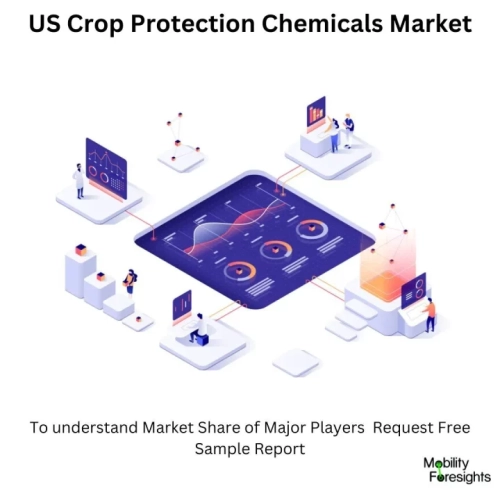
- Get in Touch with Us

Last Updated: Apr 25, 2025 | Study Period:
The US crop protection chemicals market is experiencing steady growth, largely driven by the need for higher agricultural productivity in the face of rising global food demand. Herbicides remain the most dominant segment due to their extensive use in weed management. However, growing concerns around the environmental impact of synthetic chemicals are pushing for a transition toward biopesticides and integrated pest management practices.
Technological advancements, such as the rise of precision agriculture and drone technology, are transforming the way crop protection chemicals are applied. These innovations help farmers optimize chemical use, reducing waste and lowering operational costs. However, the market faces challenges, including stringent regulatory frameworks, particularly around synthetic pesticide residues, and the volatility of raw material prices, which continue to affect profit margins.
The US crop protection chemicals market plays a critical role in supporting the nationâs vast agricultural industry. Crop protection chemicals include herbicides, insecticides, fungicides, and biopesticides, which are essential for controlling pests, weeds, and diseases that could otherwise devastate crop yields. This market is integral to ensuring food security and sustaining high levels of agricultural productivity.
There are several types of crop protection chemicals available in the US market. These include synthetic chemicals like glyphosate and atrazine, as well as more sustainable options like biopesticides and natural repellents. Herbicides dominate the market, followed by insecticides and fungicides, each serving specific needs within various crop types.

Crop protection chemicals are widely used across major agricultural sectors in the US, such as corn, soybean, wheat, and fruits & vegetables. The Midwest region remains a major consumer of these products, given its extensive agricultural activities, particularly in corn and soybean production.
Despite their benefits, the market for crop protection chemicals faces challenges. On one hand, these chemicals help increase yield and ensure crop health, but concerns about their environmental and health impacts, particularly synthetic pesticides, are growing. Stricter regulations and consumer demand for organic produce are pushing companies to innovate with safer alternatives like biopesticides.
The US crop protection chemicals market was valued at $13.8 billion in 2023 and is expected to reach $18.5 billion by 2030, growing at a compound annual growth rate (CAGR) of 4.2%. The herbicide segment, the largest by revenue, is expected to maintain its dominance, although biopesticides are projected to be the fastest-growing segment. Growth is driven by increasing food demand, innovations in precision farming, and government support for sustainable farming practices. However, fluctuating raw material costs and stringent regulations pose challenges to market expansion.

The US crop protection chemicals market is influenced by several key trends. Biopesticides are gaining traction, especially with growing environmental concerns and regulatory pressures to reduce synthetic chemical usage. Precision agriculture is another significant trend, allowing farmers to optimize chemical usage through data analytics, drones, and GPS-guided equipment. Consumer behavior is shifting toward organic and non-GMO products, pushing demand for natural alternatives to synthetic pesticides. Additionally, stricter regulations around pesticide residues are reshaping product development strategies within the industry.
By Type:
By Application:
By Region:
By Formulation:
| SI No. | Topic |
| 1 | Executive Summary |
| 2 | Market Overview |
| 3 | Key Predictions of the US Crop Protection Chemicals Market |
| 4 | Scope of the Report |
| 5 | Research Methodology |
| 6 | US Crop Protection Chemicals Market Production Footprint - 2023 |
| 7 | Technological Developments in Crop Protection Chemicals |
| 8 | Major Drivers for the US Crop Protection Chemicals Market |
| 9 | Key Trends in the US Crop Protection Chemicals Market |
| 10 | Market Size and Forecast, 2024-2030 |
| 11 | Market Size, Dynamics, and Forecast by Type, 2024-2030 |
| 12 | Market Size, Dynamics, and Forecast by Application, 2024-2030 |
| 13 | Market Size, Dynamics, and Forecast by Region, 2024-2030 |
| 14 | New Product Development in the US Crop Protection Chemicals Market |
| 15 | Competitive Landscape |
| 16 | Company Profiles |
| 17 | Unmet Needs and Opportunities |
| 18 | Leading Players |
| 19 | Government Policies and Incentives |
| 20 | Future Trends and Innovations |
| 21 | Consumer Preferences and Market Impact |
| 22 | Conclusion |